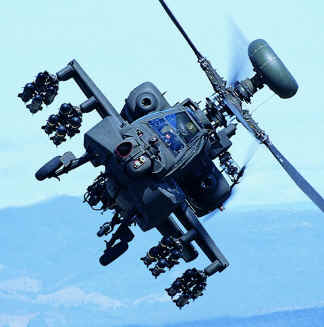The General officers of the US Army displayed
great foresight and courage with the cancellation of the Comanche helicopter
program. It proved too expensive and inappropriate for future
missions. Apache Longbows upgraded to Level III can match the capabilities
of the Comanche. While the Comanche is more agile and more difficult to
detect with sophisticated air defense systems, the Apache has much more range,
payload and armor protection. However, the plan to upgrade 501 Apaches to
expensive Longbow Block III (right) is unwise and probably unaffordable. The Apache is a great "tank
killer", but some Apaches are needed as "people killers." 
Much of the cost for the Level III Longbow Apaches are for the millimeter radar and fire control systems to provide an even more lethal method to employ $100,000 Hellfire missiles against tanks. However, fighting in Afghanistan and Iraq showed the Apache lacks the weaponry to engage infantrymen. Pods with 70mm rockets (FFAR) can be mounted in place of Hellfires, but they are fixed and difficult to aim while on the move, which the Army and Marines discovered was necessary to stay alive. Rockets are not accurate and are considered area weapons for "suppressive fire." As a result, they are not used close to friendly troops or in cities and towns.
The Apache's M230 30mm lightweight automatic cannon is effective, but limited. It fires 30mm linkless ammunition at a rate of 625 shots per minute. However, the gun duty cycle to prevent overheating is as follows: six 50-round bursts with 5 seconds between bursts followed by a 10-minute cooling period. For bursts limited settings other than 50, the duty cycle can be generalized as no more than 300 rounds fired within 60 seconds before allowing the gun to cool for ten minutes, after which the cycle may be repeated.
In short, an Apache can only fire 300 rounds before having to take a ten minute break to allow the gun to cool, and this assumes the gun never jams or malfunctions. Time on station is limited by fuel, and pilots attempting to avoid enemy anti-aircraft fire shouldn't circle aimlessly for 10 minutes after each brief gun engagement. Perhaps a rotating gatling gun is required, but that is only part of the solution.
| Primary Mission | Starboard Wing | M230 Gun | Port Wing | Rate of Climb | Duration |
| Combat (Anti-armor) |
4 Hellfire | 320 rds 30mm | 4 Hellfire | 1450 fpm | 1.8 hours |
| Multi-role (Covering force) |
4 Hellfire 19 FFAR * |
1200 rds 30mm | 4 Hellfire 19 FFAR * |
860 fpm | 2.5 hours |
| Close-support (Anti-armor) |
8 Hellfire | 1200 rds 30mm | 8 Hellfire | 990 fpm | 2.5 hours |
| Ground-support (Airmobile escort) |
38 FFAR * | 1200 rds 30mm | 38 FFAR * | 780 fpm | 2.5 hours |
The Army needs mixed squadrons, half with Longbow Apaches and half with "Gunship" Apaches, which will cost less to upgrade and operate since they will not have the sophisticated 1000 lb. Longbow system. They can adopt the flexible External Stores/Weapons System (ESWS) developed for the CH-60L Blackhawks. Past weapons integration on the Blackhawk have included Hellfire missiles, 2.75-inch Rockets, Stinger Missiles and various gun pods including 7.62 mm, 20mm and 30mm cannon. One current operational configuration has dual 30mm chain guns, dual 7.62mm machine guns and Hellfire missiles and rockets, more than doubling the firepower of existing attack helicopters. Keep in mind that more firepower means more weight and less speed and range, although the dropping the Longbow radar saves 1000 lbs. The ESWS also can accommodate up to four 230 gallon external fuel pods.
However, these are fixed systems. An aimable pod gun on each wing cued in sync with the 30mm gun may be ideal. The new General Dynamics three-barrel GAU-19 .50 caliber gatling gun (three barrels offer three times the rate of sustained fire) or the MK-19 40mm grenade launcher are good options. All three guns could be fired simultaneously, or their use rotated to allow barrel cooling. Perhaps both pilots can use a helmet aiming system to engage separate targets simultaneously.
The Army must also consider using Apaches to drop to bombs and crack open bunkers when 100 lb Hellfires cannot do the job. Each Apache stub wing should be able to carry two 500 lbs bombs; the USAF is developing 250lbs bombs as well. In low threat environments, Apaches may hover high overhead and drop dumb bombs on infantrymen hiding below. Since Apaches can hover above the range of enemy small arms, they can drop cheap dumb bombs within meters of a target even without GPS or a laser designator. In higher threat environments, Apaches may fly high and fast to release GPS and laser guided bombs. While aircraft are better suited as "bomb trucks" large airfields are not always available in places like Afghanistan. Moreover, fast moving jets are cautious about letting bombs loose to close to friendly troops, which is why enemy infantrymen in Vietnam and Afghanistan advanced toward American troops when airpower arrived.
The Comanche was cancelled because of soaring cost. However, upgraded Level III Longbows are expensive "battlefield quarterbacks" too. The Army doesn't need all Apaches serving as quarterbacks, but it does need cheaper Gunfighters equipped for sustained close-in support for soldiers on the ground. Canceling the Comanche has left 400 Army helicopter research, development, and testing civilian employees idle; the Army has promised not to lay them off. With this manpower, it would cost little to evaluate different configurations of Apache Gunfighters which can provide soldiers with more firepower at a lower overall cost.
Carlton Meyer editorG2mil@Gmail.com
©2004 www.G2mil.com